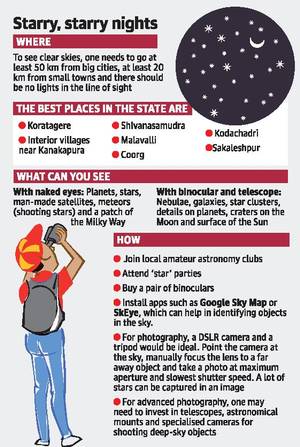For amateur astronomers who are fascinated by stars, the sky is never the limit. They look beyond it, for galaxies, stars, satellites, meteors and more. While the city’s surrounding areas offer good opportunities for stargazers, of late Bengaluru has been seeing a rise in another kind of space enthusiasm — astrophotography.
Astrophotography is the art and science of photographing objects in space. While an amateur stargazer can only retell his experiences, these photographers capture them in pictures for all to see.
“Astrophotography is picking up fast. We have a Facebook group called Indian Amateur Astrophotographer that has over 3,600 members across India. Many of them are from the city,” says Keerthi Kiran M., a system engineer who is also a member of the Bangalore Astronomical Society (BAS), a Google group with over 3,000 members that promotes astronomy as a hobby.
BAS organises regular workshops on astrophotography and talks by experts. According to Mr. Kiran, many of the group’s members are now trying out astrophotography.
Subhankar Saha, who participated in one the workshops, took up astrophotography six years ago. “Having a basic knowledge in astronomy helped me. The best season for stargazing and astrophotography is between November and May. During this time, I try to head out and photograph deep-sky objects twice a month. I generally travel to Koratagere, near Tumakuru,” he says.
Deep-sky objects include faint objects in the sky such as nebulae and galaxies.
Though Mr. Saha has advanced equipment such as an astronomical mount, a modified DSLR, a specialised camera and three telescopes, he says a beginner can even start with a good mobile phone camera, or a DSLR, and a tripod to take stunning photographs of the night sky. With advanced equipment, one can shoot star trails, the Milky Way and even faint nebulae.
“The astrophotography community is quite vibrant today. A lot of new people are getting into the hobby,” he says.
B.S. Shylaja, director, Jawaharlal Nehru Planetarium, says many students who come for astronomy sessions to the planetarium get into astrophotography. “There is a lot of interest in the subject now.”
Partying with the stars
Karthik Subramanian, who has been an amateur astronomer for about seven years, has been accompanying his friends on regular ‘star parties’ — informal gatherings of amateur astronomers. “Last month, I went on an observing trip along with my friends. We were able to capture the Milky Way through Sagittarius and Scorpius on the camera. For me, the hobby is about appreciating the wonders of nature in the sky.”
Many members of the Association of Bangalore Amateur Astronomers are also astrophotographers. Chandrashekar G., who picked up the hobby 10 years ago, started with a DSLR. Today, he carries over 40 kg of equipment to remote places around Bengaluru to shoot stars and planets.
However, serious astrophotography requires a lot of expertise. “This kind of photography is very challenging. We are trying to photograph objects in the sky which are extremely faint. Autofocus and metering do not work. So, the photographer has to manually focus and set the shutter speed to photograph the night sky. Even then, it needs a very long shutter speed to capture enough light from these faint targets,” Mr. Kiran says.
Astrophotographers use techniques where they shoot many short-exposure images and then combine them to make one image which looks like a long-exposure one. There are a lot of do-it-yourself projects that people can try to track the stars, such as using the barn door tracker, which rotates the camera at the same rate as the Earth’s rotation. And just as light pollution affects the stargazing experience, astrophotography also needs a dark, dry place far away from lights.
It is also an expensive hobby, unlike stargazing, where many objects can be seen with just the naked eye or a simple telescope. “The stars move in the sky. So long exposure can result in streaks. One needs special equipment to track the stars. Normal photographic lens may not suffice for astrophotography. Extremely good quality lenses and telescopes are needed to take good photographs,” Mr. Kiran says.
Some equipment are not available in India and need to be imported. “One requires a lot of passion and a deep purse to pursue this hobby. But, once you get into it, it is very rewarding,” says Mr. Chandrashekar.
source: http://www.thehindu.com / The Hindu / Home> News> Cities> Bengaluru / by Sarumathi K / Bengaluru – May 20th, 2017
